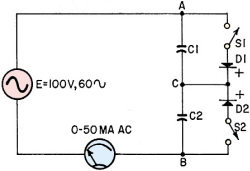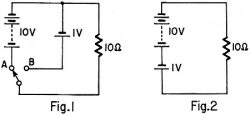|
March 1963 Radio-Electronics
 [Table of Contents] [Table of Contents]
Wax nostalgic about and learn from the history of early electronics.
See articles from Radio-Electronics,
published 1930-1988. All copyrights hereby acknowledged.
|
Time to put on your
thinking caps once again. No person is credited for these three "What's Your
EQ?" challenges from the March 1963 issues of Radio−Electronics
magazine. In other instances (see below) it is E. D. Clark. BTW, EQ stands for
Electronics Quotient. My solution for the "Four−Bulb Puzzler" was different from
the one proposed. Given that semiconductor diodes were available at the time, I
put a 6.2−V zener diode (a common value at the time) across each bulb, figuring
if the bulb burnt out (open-circuited), the zener would drop the voltage
normally dropped by the 6 V bulb. While the bulb is operating, the voltage
across the zener would not turn it on. Of course there could be a problem with
the current through the diode being too high when turned on, without a limiting
resistor. "Simple Circuit?" would take more time than I am willing to expend
right now. With "Ohms, Sweet Ohms" don't let the wording of the proposition bias
(pun intended) your analysis. Bon chance!
What's Your EQ?
 Three puzzlers for the student, theoretician and practical man. They may look
simple, but double-check your answers before you say you've solved them. If you've
got an interesting or unusual answer send it to us. We are especially interested
in service stinkers or engineering stumpers on actual electronic equipment. We are
getting so many letters we can't answer individual ones, but we'll print the more
interesting solutions (the ones the original authors never thought of). We will
pay $10 and up for each one accepted. Write EQ Editor, Radio-Electronics, 154 West
14th St., New York, N. Y. Three puzzlers for the student, theoretician and practical man. They may look
simple, but double-check your answers before you say you've solved them. If you've
got an interesting or unusual answer send it to us. We are especially interested
in service stinkers or engineering stumpers on actual electronic equipment. We are
getting so many letters we can't answer individual ones, but we'll print the more
interesting solutions (the ones the original authors never thought of). We will
pay $10 and up for each one accepted. Write EQ Editor, Radio-Electronics, 154 West
14th St., New York, N. Y.
Answers for this month's puzzlers are at bottom of page.
 Four-Bulb Puzzler Four-Bulb Puzzler
Each black box in the diagram contains a single electronic component,
connected in parallel with a 6-volt bulb. If one bulb burns out, the others remain lighted
- the black box across the extinguished bulb carries the load and the total current
is reduced slightly. What is in each black box? (The black boxes do not contain
any of the following: fixed resistor; capacitor; relay or other electromechanical
device.)
- Kendall Collins
 Simple Circuit? Simple Circuit?
In the circuit shown, an alternating voltage E of 100 rms, 60 cycles, is connected
to two capacitors, C1 and C2, in series. First, let C1 and C2 be equal, each having
a capacitance of 2 μf. The series combination has then a value of 1 μf, which
at 60 cycles will have a reactance of 2,650 ohms. The alternating current flowing
in the circuit will be approximately 38 ma.
Closing switches S1 and S2 places diodes D1 and D2 across capacitors C1 and C2,
respectively. Note that the diodes are connected back to back!
1. If S1 and S2 are both closed, will this change the reactance of the circuit,
compared to the case when the switches are open? In other words, will the alternating
current change?
2. What will a high-resistance DC voltmeter read, when placed across C1 and then
across C2?
3. If only one of the switches, say S1, is closed, what will be the effect on
the reactance - that is, on the alternating current?
4. And what will the DC voltages be across C1 and C2 with only S1 closed?
Better not be too sure that you know all about such a simple circuit! It might
be smart to set up the circuit and measure the values. Chances are you won't believe
what you find!
- Walter Richter
 Ohms, Sweet Ohms Ohms, Sweet Ohms
Didn't know resistors could amplify, eh? Well, watch. With the switch in position
A (Fig. 1), 10 volts will be applied across the 10-ohm resistor, giving us a current
of 1 ampere. The power by P = EI will be 10 x 1 = 10 watts. When we switch to position
B, 1 volt across 10 ohms will give us 0.1 amp, and a power of 1 x 0.1 = 0.1 watt.
Now let's find the power when both batteries are used (Fig. 2).
Eleven volts across 10 ohms gives us a current of 1.1 amps, with the resulting
power of 11 x 1.1 = 12.1 watts. But hold it! The 10-volt battery delivers 10 watts,
and the 1-volt battery 0.1 watts, making for a total of 10.1 watts. Yet the combination
gave us 12.1 watts! Where did the 2 watts come from?
- John Timar, Jr.
Quizzes from vintage electronics magazines such as Popular
Electronics, Electronics-World, QST, and Radio News
were published over the years - some really simple and others not so simple. Robert P. Balin
created most of the quizzes for Popular Electronics. This is a listing
of all I have posted thus far.
- RF Cafe Quiz #71:
Tech Headlines for Week of 3/13/2023
- RF Cafe Quiz #70:
Analog &
RF Filter Basics
- RF Cafe Quiz #69:
RF
Electronics Basics
- RF Cafe Quiz #68:
RF & Analog Company Mergers & Acquisitions in 2017
- RF Cafe Quiz #67:
RF & Microwave Company Name Change History
- RF Cafe Quiz #66:
Spectrum and Network Measurements
- RF Cafe Quiz #65:
Troubleshooting & Repairing Commercial Electrical Equipment
- RF Cafe Quiz #64:
Space-Time Adaptive Processing for Radar
- RF Cafe Quiz #63:
Envelope Tracking Power Amplifiers
- RF Cafe Quiz #62:
Stimson's Introduction to Airborne Radar
- RF Cafe Quiz #61:
Practical Microwave Circuits
- RF Cafe Quiz #60:
Ten Essential Skills for Electrical Engineers
- RF Cafe Quiz #59:
Microwave Circulator Design
- RF Cafe Quiz #58:
Microwave and Millimeter-Wave Electronic Packaging
- RF Cafe Quiz #57:
Frequency-Agile Antennas for Wireless Communications
- RF Cafe Quiz #56:
Tube Testers
and Electron Tube Equipment
- RF Cafe Quiz #55:
Conquer
Radio Frequency
- RF Cafe Quiz #54:
Microwave Mixer Technology and Applications
- RF Cafe Quiz #53:
Chipless RFID Reader Architecture
- RF Cafe Quiz #52:
RF and Microwave Power Amplifiers
- RF Cafe Quiz #51:
Antennas and Site Engineering for Mobile Radio Networks
- RF Cafe Quiz #50:
Microstrip Lines and Slotlines
- RF Cafe Quiz #49:
High-Frequency Integrated Circuits
- RF Cafe Quiz #48:
Introduction to Infrared and Electro-Optical Systems
- RF Cafe Quiz #47:
LCP for Microwave Packages and Modules
- RF Cafe Quiz #46:
RF, Microwave, and Millimeter-Wave Components
- RF Cafe Quiz #45:
Dielectric and Thermal Properties of Materials at Microwave Frequencies
- RF Cafe Quiz #44:
Monopulse Principles and Techniques
- RF Cafe Quiz #43:
Plasma Antennas
- RF Cafe Quiz #42: The Micro-Doppler
Effect in Radar
- RF Cafe Quiz #41: Introduction
to RF Design Using EM Simulators
- RF Cafe Quiz #40: Introduction
to Antenna Analysis Using EM Simulation
- RF Cafe Quiz #39: Emerging
Wireless Technologies and the Future Mobile Internet
- RF Cafe Quiz #38: Klystrons,
Traveling Wave Tubes, Magnetrons, Crossed-Field Amplifiers, and Gyrotrons
- RF Cafe Quiz #37: Component
Reliability for Electronic Systems
- RF Cafe Quiz #36: Advanced
RF MEMS
- RF Cafe Quiz #35: Frequency
Synthesizers: Concept to Product
- RF Cafe Quiz #34: Multi-Gigabit
Microwave and Millimeter-Wave Wireless Communications
- RF Cafe Quiz #33: Battlespace
Technologies: Network-Enabled Information Dominance
- RF Cafe Quiz #32: Modern Communications
Receiver Design and Technology
- RF Cafe Quiz #31: Quantum
Mechanics of Nanostructures
- RF Cafe Quiz #30: OFDMA System
Analysis and Design
- RF Cafe Quiz #29: Cognitive
Radar
- RF Cafe Quiz #28: Human-Centered
Information Fusion
- RF Cafe Quiz #27: Remarkable
Engineers
- RF Cafe Quiz #26: Substrate
Noise Coupling in Analog/RF Circuits
- RF Cafe Quiz #25: Component
Reliability for Electronic Systems
- RF Cafe Quiz #24: Ultra Low
Power Bioelectronics
- RF Cafe Quiz #23: Digital
Communications Basics
- RF Cafe Quiz #22: Remember
the Basics?
- RF Cafe Quiz #21: Wireless
Standards Knowledge
- RF Cafe Quiz #20: Famous First
Names
- RF Cafe Quiz #19: Basic Circuit
Theory
- RF Cafe Quiz #18: Archaic
Scientific Words & Definitions
- RF Cafe Quiz #17: Inventors &
Their Inventions
- RF Cafe Quiz #16: Antennas
- RF Cafe Quiz #15: Numerical
Constants
- RF Cafe Quiz #14: Oscillators
- RF Cafe Quiz #13: General
Knowledge
- RF Cafe Quiz #12: Electronics
Corporations Headquarters
- RF Cafe Quiz #11: Famous Inventors &
Scientists
- RF Cafe Quiz #10: A Sampling
of RF & Wireless Topics
- RF Cafe Quiz #9: A Smorgasbord
of RF Topics
- RF Cafe Quiz #8: Hallmark Decades
in Electronics
- RF Cafe Quiz #7: Radar Fundamentals
- RF Cafe Quiz #6: Wireless Communications
Fundamentals
- RF Cafe Quiz #5: Company Logo
Recognition
- RF Cafe Quiz #4: General RF
Topics
- RF Cafe Quiz #3: General RF/Microwave
Topics
- RF Cafe Quiz #2: General RF
Topics
- RF Cafe Quiz #1: General RF
Knowledge
- Vacuum Tube Quiz,
February 1961 Popular Electronics
- Kool-Keeping Kwiz, June
1970 Popular Electronics
- Find the Brightest
Bulb Quiz, April 1960 Popular Electronics
-
Where Do the Scientists Belong? - Feb 19, 1949 Saturday Evening Post
|
-
What's Your EQ? - April 1967 Radio-Electronics
-
What's Your EQ? -
March 1967 Radio-Electronics
-
What's Your EQ? - December 1964 Radio-Electronics
-
What's Your EQ? - January 1967 Radio-Electronics
-
Wanted: 50,000 Engineers - January 1953 Popular Mechanics
-
What's Your EQ? - August 1964 Radio-Electronics
- Voltage Quiz
- December 1961 Popular Electronics
-
What is It? - June 1941 Popular Science
- What Do You Know
About Resistors? - April 1974 Popular Electronics
-
What's Your EQ? - September 1963 Radio-Electronics
- Potentiometer Quiz - September
1962 Popular Electronics
-
Mathematical Bafflers - March 1965 Mechanix Illustrated
- Op Amp Quiz -
October 1968 Popular Electronics
- Electronic "A"
Quiz - April 1968 Popular Electronics
-
What's Your EQ? - May 1961 Radio-Electronics
-
Popular Science Question Bee - February 1939 Popular Science
-
What is It? - A Question Bee in Photographs - June 1941 Popular Science
-
What's Your EQ? - June 1961 Radio-Electronics
-
What's Your EQ? - June 1964 Radio-Electronics
-
What's Your EQ? - May 1964 Radio-Electronics
-
What's Your EQ? - August 1963 Radio-Electronics
-
What's Your EQ? - May 1963 Radio-Electronics
- Bridge
Function Quiz - September 1969 Radio-Electronics
-
What's Your EQ? - March 1963 Radio-Electronics
-
What's Your EQ? - February 1967 Radio-Electronics
-
Circuit Quiz - June 1966 Radio-Electronics
-
What's Your EQ? - June 1966 Radio-Electronics
- Electronics
Mathematics Quiz - June 1969 Popular Electronics
- Brightest
Light Quiz - April 1964 Popular Electronics
-
What's Your EQ? - April 1963 Radio-Electronics
- Electronics "B" Quiz
- July 1969 Popular Electronics
- Ohm's Law Quiz
- March 1969 Popular Electronics
-
Antenna Quiz - November 1962 Electronics World
- Color Code Quiz
- November 1967 Popular Electronics
- CapaciQuiz
- August 1961 Popular Electronics
- Transformer
Winding Quiz - December 1964 Popular Electronics
-
Audiophile Quiz - November 1957 Radio-electronics
- Capacitor
Function Quiz - March 1962 Popular Electronics
- Greek Alphabet
Quiz - December 1963 Popular Electronics
- Circuit
Designer's Name Quiz - July 19680 Popular Electronics
-
Sawtooth Sticklers Quiz - November 1960 Radio-Electronics
-
Elementary
Radio Quiz - December 1947 Radio-Craft
- Hi-Fi
Quiz - October 1955 Radio & Television News
- Electronics Physics
Quiz - March 1974 Popular Electronics
- A Baffling Quiz
- January 1968 Popular Electronics
- Electronics IQ
Quiz - May 1967 Popular Electronics
- Plug and Jack
Quiz - December 1967 Popular Electronics
- Electronic
Switching Quiz - October 1967 Popular Electronics
- Electronic
Angle Quiz - September 1967 Popular Electronics
- International
Electronics Quiz - July 1967 Popular Electronics
- FM Radio
Quiz - April 1950 Radio & Television News
- Bridge Circuit
Quiz -December 1966 Popular Electronics
- Diode Function
Quiz - August 1965 Popular Electronics
- Diagram Quiz,
August 1966 Popular Electronics
- Quist Quiz - November
1953 QST
- TV Trouble Quiz,
July 1966 Popular Electronics
- Electronics History Quiz,
December 1965 Popular Electronics
- Scope-Trace Quiz,
March 1965 Popular Electronics
-
Electronic
Circuit Analogy Quiz, April 1973
-
Test Your Knowledge of Semiconductors, August 1972 Popular Electronics
- Ganged Switching
Quiz, April 1972 Popular Electronics
- Lamp Brightness
Quiz, January 1969 Popular Electronics
- Lissajous
Pattern Quiz, September 1963 Popular Electronics
- Electronic
Quizoo, October 1962 Popular Electronics
- Electronic
Photo Album Quiz, March 1963 Popular Electronics
- Electronic
Alphabet Quiz, May 1963 Popular Electronics
- Quiz: Resistive?
Inductive? or Capacitive?, October 1960 Popular Electronics
- Vector-Circuit
Matching Quiz, June 1970 Popular Electronics
- Inductance
Quiz, September 1961 Popular Electronics
- RC Circuit Quiz,
June 1963 Popular Electronics
- Diode Quiz, July
1961 Popular Electronics
- Electronic
Curves Quiz, February 1963 Popular Electronics
- Electronic
Numbers Quiz, December 1962 Popular Electronics
- Energy Conversion
Quiz, April 1963 Popular Electronics
- Coil Function
Quiz, June 1962 Popular Electronics
-
Co-Inventors Quiz - January 1965 Electronics World
-
"-Tron" Teasers Quiz - October 1963 Electronics World
- Polarity Quiz
- March 1968 Popular Electronics
-
Television
I.Q. Quiz - October 1948 Radio & Television News
- Amplifier Quiz
Part I - February 1964 Popular Electronics
- Semiconductor
Quiz - February 1967 Popular Electronics
- Unknown
Frequency Quiz - September 1965 Popular Electronics
- Electronics
Metals Quiz - October 1964 Popular Electronics
- Electronics
Measurement Quiz - August 1967 Popular Electronics
- Meter-Reading
Quiz, June 1966 Popular Electronics
- Electronic
Geometry Quiz, January 1965 Popular Electronics
- Electronic
Factor Quiz, November 1966 Popular Electronics
- Electronics
Math Quiz, November 1965 Popular Electronics
- Series Circuit
Quiz, May 1966 Popular Electronics
- Electrochemistry
Quiz, March 1966 Popular Electronics
- Biz
Quiz: Test Your Sales Ability - April 1947 Radio News
- Electronic
Analogy Quiz, November 1961 Popular Electronics
- Electronic
Coupling Quiz, August 1973 Popular Electronics
- Electronics
Analogy Quiz, August 1960 Popular Electronics
- Audio Quiz, April
1955 Popular Electronics
- Electronic Unit
Quiz, May 1962 Popular Electronics
- Capacitor
Circuit Quiz, June 1968 Popular Electronics
|
These are the answers.
Four-Bulb Puzzler
Each black box contains a thermistor. The thermistors are not appreciably heated
by the voltage drop across a lighted bulb. When a bulb burns out, the voltage drop
across the thermistor is increased and its temperature increases. This brings its
resistance to a value suitable for replacing the open bulb filament.
Simple circuit?
1. Reactance of two capacitors, each of 2 μf, in series, is 2,650 ohms. This
value will not be affected by the presence of the diodes. The alternating current
will be 38 ma, with or without the diodes.
2. 71 volts, with C positive with respect to A or B.
3. and 4. One diode can be left out of the circuit without changing the statements
under 1 and 2.
Ohms, sweet ohms
But wattage = E x I, and in the second situation both E and I are changed! The
10-volt battery that delivered 1 amp per cell is delivering 1.1 amp, or 11 watts,
and the current from the 1-volt cell is also 1.1 instead of 0.1 amp, giving a wattage
of 11 x 1.1. Total: 12.1 watts.
Posted May 11, 2023
|

 Three puzzlers for the student, theoretician and practical man. They may look
simple, but double-check your answers before you say you've solved them. If you've
got an interesting or unusual answer send it to us. We are especially interested
in service stinkers or engineering stumpers on actual electronic equipment. We are
getting so many letters we can't answer individual ones, but we'll print the more
interesting solutions (the ones the original authors never thought of). We will
pay $10 and up for each one accepted. Write EQ Editor, Radio-Electronics, 154 West
14th St., New York, N. Y.
Three puzzlers for the student, theoretician and practical man. They may look
simple, but double-check your answers before you say you've solved them. If you've
got an interesting or unusual answer send it to us. We are especially interested
in service stinkers or engineering stumpers on actual electronic equipment. We are
getting so many letters we can't answer individual ones, but we'll print the more
interesting solutions (the ones the original authors never thought of). We will
pay $10 and up for each one accepted. Write EQ Editor, Radio-Electronics, 154 West
14th St., New York, N. Y. 

